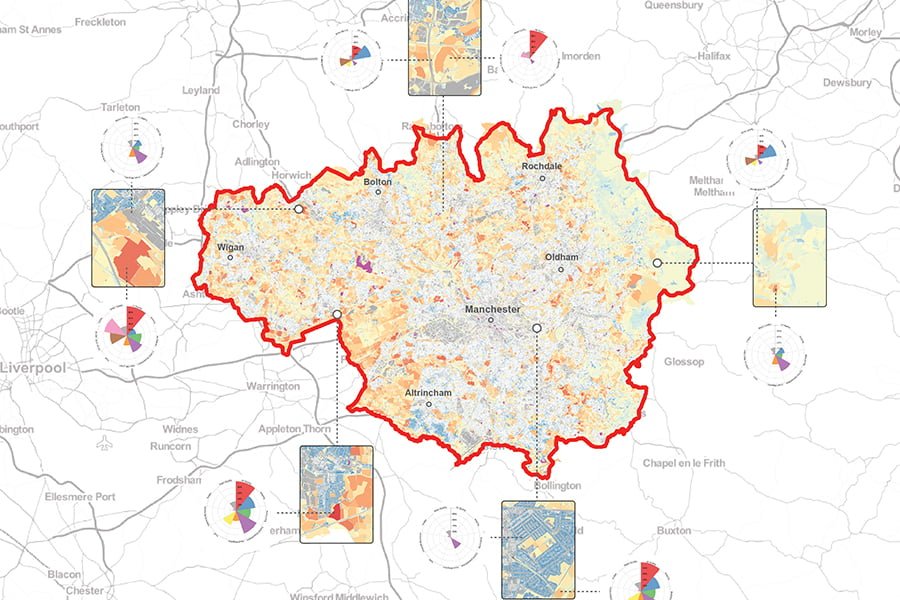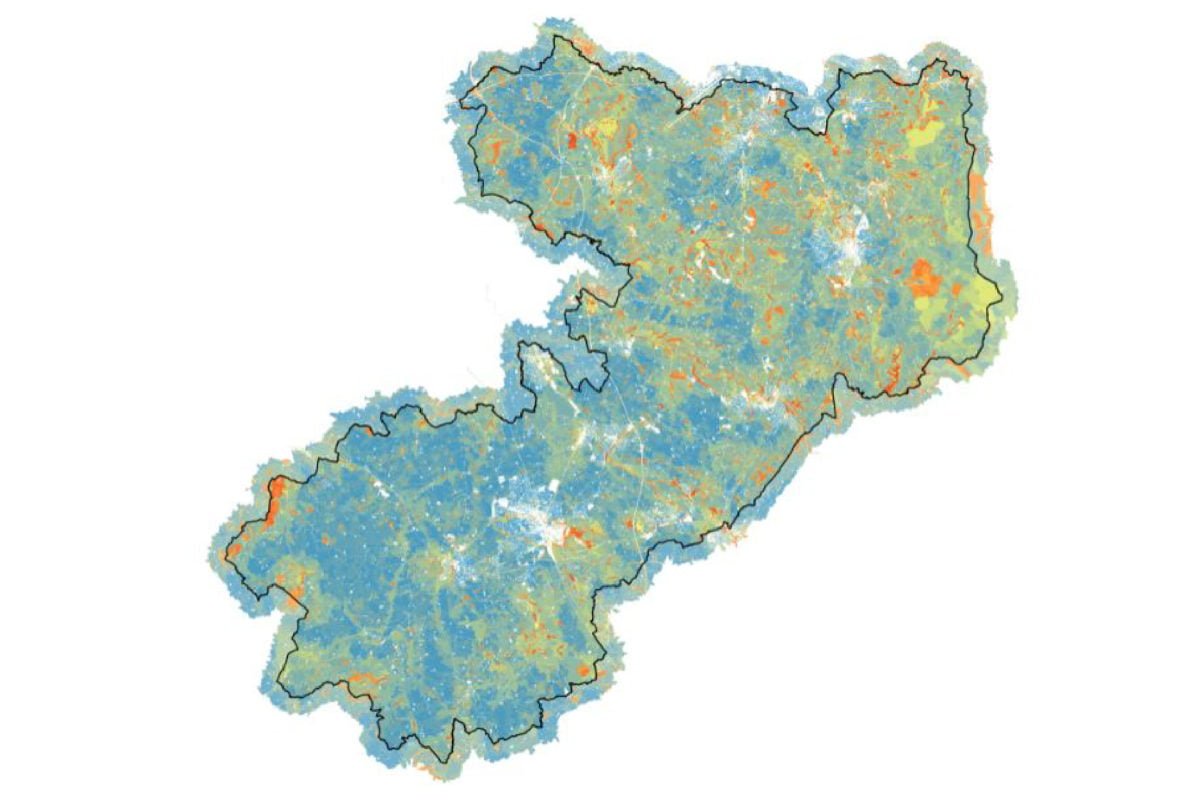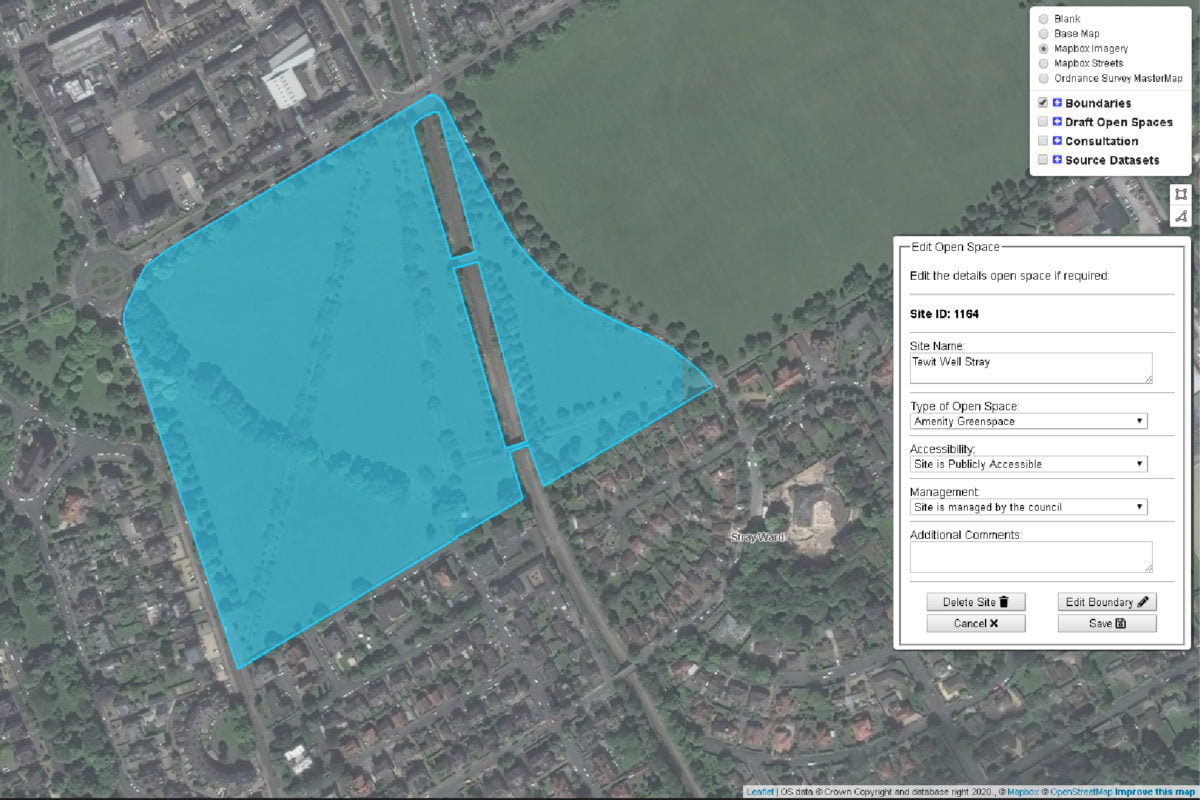
Since its inception in 1997, TEP has always sought to use technology and spatial information to understand the world in which we live. Through the study of spatial relationships, we can learn how to analyse and improve the natural, social and built environment. Geographic Information Systems (GIS) provides an incredibly powerful tool, one which can provide insight and clarity to the world around us.
TEP continually develops and incorporates GIS approaches and solutions into our projects, from traditional ecological site-based assessments through to large scale strategic studies across regions. Being able to understanding and interpret spatial data is critical to the successful delivery of projects.
In the past two years, TEP has established and strengthened a nine-strong GIS team. It has supported all of our services and many projects across the business and has taken the lead in delivering their own ground-breaking geospatial commissions. One of these led to the GIS team winning a Landscape Institute Award in the Transforming through Management and Science category.
“As our commissions have grown,
so have we.”
As the GIS team has expanded its range of skills, clients and project portfolios, it has delivered many challenging and exciting commissions including:
Ecosystem Services (ESS) Opportunity Mapping in the River Irwell Catchment

The ESS Opportunities Mapping Tool identifies where ESS could be enhanced within the Irwell Catchment. It also communicates the opportunities for Green Infrastructure improvements that would increase the flow of ESS. The mapping helped validate Greater Manchester Combined Authority’s (GMCA) project ideas and stimulate further development opportunities; ranging from small scale enhancements to larger ambitious proposals. Providing a better understanding of the significant monetary value of the ESS can help direct investment to areas that need it the most. The project sets a precedent whereby GMCA and their stakeholders were provided with a robust evidence base, which has been integrated with the MappingGM web tool. This means interested parties can use the tool to identify and implement further opportunities. The innovative method used in the project is wholly replicable and could be used across different landscapes and at varying scales. This has been demonstrated through a subsequent commission to expand the application to Greater Manchester, the results of which can be seen on MappingGM.
The Mersey Forest – GIS Development and Support

Mersey Forest plays a key role in the development and engagement of woodlands across North Cheshire and Merseyside, which provide vital benefits to local communities. The organisation is also involved in the delivery of many large-scale projects, which includes The Northern Forest; a 25-year vision to plant 50 million trees across the North of England, stretching from Liverpool to Hull. TEP has worked closely with The Mersey Forest for several years on projects, as well as Corporate Social Responsibility activities. TEP’s GIS team has a wealth of experience in desktop spatial software ArcGIS and QGIS; spatial databases PostgreSQL and PostGIS; and web mapping technologies such as Leaflet.JS. It will use these to support The Mersey Forest’s internal business processes, and on other funded projects. For more information about our support, follow this link.
Ellesmere Port – Tree Opportunity Mapping
The importance of trees and their contribution to public health, the economy and the environment is well-documented. TEP is working with The Mersey Forest and Cheshire West Council to identify suitable areas for additional tree planting in Ellesmere Port. This will help enhance these benefits for the local community and surrounding wildlife. Potential opportunities are identified through our bespoke methodology, which evaluates a land parcel’s feasibility for tree planting, alongside the benefits it could provide to help mitigate air pollution, flooding and deprivation. TEP has built a web mapping decision-making tool for Cheshire West Council to explore the datasets created as part of the study and access all of the information in a user-friendly way.
Harrogate Open Space Audit

A local authority’s GIS dataset for open spaces is vital to evaluate the current provision of open space in strategic planning, as well as ongoing management and maintenance. TEP is working with Harrogate Borough Council to update their open spaces dataset. This is an iterative process using existing GIS sources of greenspace information and the invaluable local knowledge of council officers. TEP looked to overcome the challenges to consultation, posed by remote working, by creating a custom-made web mapping tool. The tool let council officers edit the existing GIS information and add new open spaces where appropriate. This process allowed all officers to access and contribute information from any working environment without the need for specialist software.
Manchester River Valley Strategy
Our local water environment is important to our quality of life. It services crucial economic, social and environmental functions from the obvious resource supply and flood management, through to the less obvious and more intangible creative inspiration, social cohesion and mental well-being. The Irk (Wince to Irwell), Medlock (Lumb Brook to Irwell) and Mersey are the City of Manchester’s three main river valleys. The City’s river valleys comprise a significant proportion of its total green and blue infrastructure resource and their potential must be considered both at a neighbourhood and city-wide level. Manchester is at the forefront of a worldwide movement to use the understanding of the value of rivers and other forms of blue and green infrastructure to deliver more joined-up policy-making across planning, health, regeneration and the environment. It will help develop new investment mechanisms which will drive greater and a more cost-effective impact across a range of public services. Our methodology is focussed on building on the wealth of data and reporting in Manchester. It uses this information to fill gaps in the evidence base and create consensus around the strategies and deliverable action plans for Manchester’s river valleys. Our outputs will include the GIS database, river valleys strategies and action plans to provide a lasting legacy for the City.
The Team

TEP’s highly-skilled GIS team are experts in the use of many mapping products including ArcGIS, QGIS, PostgreSQL and PostGIS. They have developed innovative mapping and GIS solutions on a range of projects including Greenspace Assessment, Landscape Maintenance, Green Infrastructure, Risk Management, and Ecosystem Services.
The GIS Team is managed by Associate Director Mike Hodgkinson who has been with TEP for 15 years and has a proven track record in team and project management. Mike is supported in the management and development of the GIS Team by Senior GIS Consultants Amanda Plumb and Monika Klamann, who have extensive experience in Ecological Assessments, Large Scale Projects and management of resources during our busy Ecological survey season. Andy Harney is the team’s Principal Spatial Developer and is the technical lead for the team. He provides a wealth of knowledge of GIS Software and is fluent in programming languages such as JavaScript, Python, C, .Net and SQL. Joe O’ Reilly is a Senior GIS Consultant, who has recently completed his MSc in GIS and led on our BNG research and development project, as well as many Green Infrastructure and Open Space Studies. GIS Consultant Conor Wardale leads on Strategic Development Constraints mapping for several high profile clients and projects. GIS Consultant Sarah Atkinson leads on Landscape and Visual Impact Assessment supporting our Environment Planning Team. Last but by no means least, we have our two new recruits, GIS Graduates Claire Powell and Josh Kelly, who increase and further strengthen the team’s resources.
“Investing in the team’s future, even during these current challenging times, is vital to TEP’s growth and a testament to TEP’s values and its resilience.”
The whole team has been part of a year-long training programme, building on their core skills in traditional GIS software, whilst also expanding into new areas such as web mapping. In a technical profession such as GIS, time allocated for challenging training is essential to inspire team members and to spark ideas for the future applications of GIS. In addition to recruitment and training, the team is building on our excellent relationships with Universities such as Sheffield Hallam, Lancaster, and Manchester. As well as looking at potential opportunities for lecturing and mentoring in collaboration with the Royal Geographical Society. These developing relationships will help with our commitment to offering support and a pathway to professional accreditation for each member of the GIS Team.
The story doesn’t stop here, discover more from the GIS Team here.








